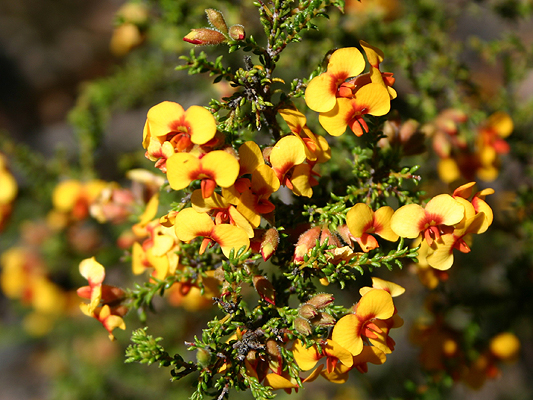Description
Common names
Small-leaf Parrot-pea, Published As "species Complex", Showy Parrot Pea.
Scientific names
Dillwynia phylicoides.
Family
Fabaceae.
Genus
Dillwynia.
Name origin
Dillwynia, after British botanist Lewis Weston Dillwyn (1778-1855). Phylicoides, from genus Phylica and oides, like, referring to small narrow leaves which resemble those of Phylica genus.
Rainfall
400mm+.
Growth rate
Moderate.
Growth height
Up to 1.5m.
Presence in Australia
Quite widespread, predominantly in drier areas west of the Hume Highway. Noted in the areas Yarra Yarra; Four Mile; Coppabella; Lower Sandy; Coreinbob; O"Briens South & McLeods; Burkes & Graveyard, and Mates Gully.
This specie has been identified in the following Australian states: Qld, NSW, ACT, Vic.
Habitat
Dry sclerophyll woodland to forest on acidic well-drained soils.
Habit
Prostrate to erect shrub to 1.5m high with hairy stems and spirally twisted leaves, usually 3-8 mm long.
Similar species
This species complex seems to include at least 2 species and requires critical revision.
Site preference
Well-drained soil. Tolerates frost.
Flowering
Yellow and red. Profuse terminal clusters.
Seed collection
Late Oct to late Feb. Monitor closely as seeds released immediately or within 1-2 days of maturity.
Propagation
From scarified seed or cuttings. Soak in near-boiling water for about 30 seconds, before cooling rapidly under flowing cold water. Alternatively soak in cold water for several hours. Dry to prevent rotting before sowing. Germination takes 3-4 weeks. Suitable for direct seeding in pots (2-3 seeds per pot).
Shade and shelter
Low-level cover in windbreaks.
Land protection
Legume - improves soil fertility through "fixing" nitrogen.
Wildlife
Important component of understorey layer.
Ornamental
Ornamental for gardens. Very hardy. Responds to hard pruning.


